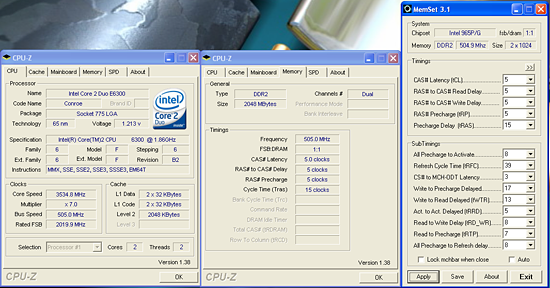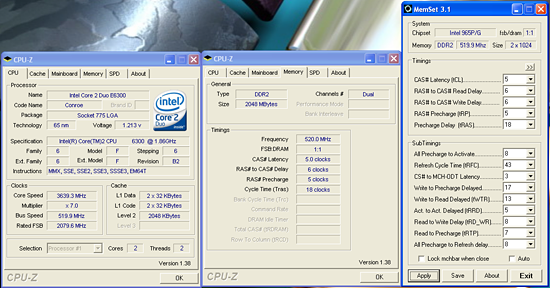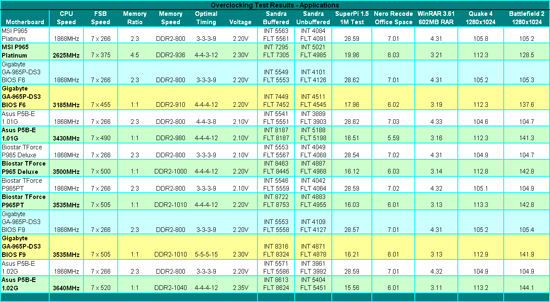
Original Link: https://www.anandtech.com/show/2148
Gigabyte GA-965P-DS3: Lab Testing Update
by Gary Key on January 4, 2007 9:00 AM EST- Posted in
- Motherboards
One of our favorite P965 boards in the labs over the past couple of months has been the Gigabyte GA-965P-DS3. Our experience with this particular motherboard has ranged from joyous moments regarding its performance and stability to downright disappointment with its quirks at launch and continuing Micron D9 memory compatibility issues. The latter has been a hindrance to extreme overclocking... until very recently. As a recap, our first experiences with the board were mainly positive but like most first release motherboards based upon new chipsets, it did have a fair share of issues that have since been solved for the most part. In early testing we encountered some memory compatibility issues, the JMicron IDE controller caused most optical drives to be stuck in PIO mode, there were sporadic overclocking issues with USB peripherals, and booting at various FSB speeds didn't always work right.
These were the most common issues with the F1 or F2 BIOS release. The memory issue was a show stopper at times due to the board not wanting to boot with memory that did not provide 1.8V compatibility. The F3 BIOS release solved the majority of these first release issues along with greatly improving memory capability. While the F3 BIOS was very stable and addressed many issues, the overclocking capability of the board was still not up to par with its technical specifications. The F4 BIOS improved overclocking for the vast majority of users, but the E6600, E6700, and X6800 CPUs were still not clocking to the same levels as on 975X motherboards. Of course, we continued to recommend the E6300 or E6400 CPUs as they are best suited for the P965 chipset. This is especially true for those who want to overclock these processors as the P965 chipset has proven itself up to the 550FSB level to date, although the memory performance penalty at these levels is horrendous at times. The F5, F6, and F7 BIOS releases resulted in additional memory compatibility, performance tweaking, improved overclocking of the 4MB equipped Core 2 Duos, and other minor fixes but the overall overclocking aspects were not really improved when compared to the F4 BIOS. Overall, we found the F5 BIOS offered the best mix of performance, compatibility, and stability of the various BIOS releases but we knew Gigabyte could do better.

During our testing of these BIOS releases we continued to experience overclocking issues once we passed the 450FSB mark. The overclocking limit was due to issues with memory modules based on Micron D9 (G). The Micron D9 (G) IC continues to be the performance leader in the upper end memory market and is generally a requirement at this time for DDR2 modules exceeding 900MHz on a regular basis. Since the lowest memory ratio offered by the Intel P965 chipset at this time is 1:1 Micron D9 (G) based memory is a requirement for overclocking past 450FSB rates. Gigabyte continued to promise overclocking improvements when using Micron D9 based memory modules in each BIOS release but it was not until the F8I beta release that we truly noticed any improvements.
The F8I BIOS cured most of the overclocking issues along with providing some other updates, but it seemed as if the final F8 BIOS release lost some overclocking capability and introduced cold boot issues in certain systems. It did offer overclocking profiles in the BIOS along with Creative X-FI compatibility fixes, but the DS3 still wasn't as good as some alternative P965 motherboard offerings. After hearing our complaints and those of users, Gigabyte quickly followed up with the F9 BIOS release. Our testing to date reveals the F9 BIOS has once again improved the overclocking of this board at the expense of memory timings at the upper end, but performance does not suffer significantly when compared to other motherboards in the same price range. Other improvements in the F9 BIOS include further Kentsfield tweaks along with official support for the upcoming 1333FSB rated processors. We have also noted that certain cold boot issues such as overclocking settings disappearing have been solved in our test bed configuration, but we still feel like the memory timings need some fine tuning.
Let's take a quick look at the overclocking performance of the DS3 with the F9 BIOS now.
Overclocking
| Gigabyte GA-965P-DS3 Overclocking Testbed |
|
| Processor: | Intel Core 2 Duo E6300 Dual Core, 1.86GHz, 2MB Unified Cache 1066FSB, 7x Multiplier |
| CPU Voltage: | 1.5000V (default 1.3250V) |
| Cooling: | Scythe Infinity Air Cooling |
| Power Supply: | OCZ GameXStream 700W |
| Memory: | Geil PC2-6400 800MHz Plus (2x1GB- GX22GB6400PDC) (Micron Memory Chips) |
| Video Cards: | 1 x MSI X1950XTX |
| Hard Drive: | Seagate 320GB 7200RPM SATA2 16MB Buffer |
| Case: | Cooler Master CM Stacker 830 |
| Maximum CPU OC: (Standard Ratio) |
505x7 (5-5-5-15, 1:1, 2.3V), CPU 1.5000V, C2 Stepping 3535MHz (+89%) |
| . | |
 |
| Click to enlarge |
Our combination of components resulted in a maximum stable overclock of 7x505 FSB with the F9 BIOS. This is an improvement of 50FSB over the F6 BIOS and 30FSB over the F8 BIOS release. We were also able to boot and enter Windows XP at 7x505 with our memory set at 4-4-4-12, but we had to change our memory settings to 5-5-5-15 for the system to complete the entire benchmark suite (including eight hours of dual Prime95). The performance penalty from running the relaxed memory latencies was minimal in our benchmark testing but still resulted in a one to two percent decrease in several of the benchmarks. Overall, the improvements in this BIOS release are somewhat amazing considering our previous test results. However, these results mean that the DS3 just now equals other boards in the same price range. We still value stability and overall system performance over high FSB rates that will only be used by a minority of users but this board now offers the best of both worlds to a certain degree.
 |
| Click to enlarge |
We optimized the MCH (+.2V) , FSB (+.2V), and Memory (+.5V) voltages and were able to run the majority of our benchmark test suite at the 7X520 FSB setting but at very relaxed 5-6-5-18 settings. In order to complete the dual Prime95 testing we had to further relax our memory timings to 5-7-6-20, which resulted in the majority of our benchmark scores being worse than our 7x505 results. Our ASUS P5B-E 1.02G motherboard will run our entire benchmark test suite at 4-4-4-12 memory timings at the same 7x520FSB,so we feel Gigabyte still has some memory and MCH tuning to complete in the next BIOS release. Considering the fact that Gigabyte has already stated the motherboard needs a resistor change to exceed the 520FSB level, we believe the BIOS engineers have maxed out the board from an overclocking viewpoint and should concentrate on memory performance now. We have the revision 2 board in-house for testing currently and will have results up in the near future as this board utilizes the same BIOS but has an optimized electrical layout for improved performance.
Test Applications
We are utilizing an abbreviated set of benchmarks to show the impact of the overclocking improvements upon memory performance, general applications, and a couple of games. We will utilize SiSoft Sandra 2007 for the Buffered and Unbuffered memory scores; SuperPi 1.5 1M, Nero Recode 2 utilizing Office Space DVD conversion, and WinRAR 3.61 along with our custom 602MB directory test for general reference scores. Our Quake game benchmark utilizes the IdNetDemo demo recording. This includes mainly outdoor areas with numerous players trying to eliminate each other. We tested the game with High Quality settings (uncompressed normal maps), and we enabled all the advanced graphics options except for VSync. This game is sensitive to memory latency changes and is a good indicator of how memory settings can affect the performance of certain games. Our Battlefield 2 benchmark utilizes our in-house recording based on the 1.3 release. This recording includes numerous players and vehicles battling it out on the Daqing Oilfield map. We tested the game with High Quality settings enabled. We have found this game to be sensitive to both CPU and GPU changes. Since our GPU remains constant we will see the effects of our FSB overclocking along with memory latency changes on the final score.
 |
| Click to enlarge |
In our memory synthetic tests we see the results at 7x266 FSB are nearly the same between the F6 and F9 BIOS releases, indicating no real changes in the internal BIOS settings. The general application and game tests follow the same path with the differences being minor. This confirms what Gigabyte told us: they have further optimized the BIOS for overclocking without affecting the stock performance adversely.
However, we do see minor differences in the benchmark results due to the relaxed memory timings when compared to the Biostar TForce P965PT running at the same 7x505 FSB settings. Although there are performance differences between the 7x455 and 7x505 settings on the DS3 we find they are very minor overall and bode well for users who have DDR2 memory that is capable of low latency settings at the 450FSB level on this board. We feel like the 450 to 470 FSB range on this board is optimal due to memory timings, the ability to use most DDR2-800 modules at these memory speeds, and the ability to run the CPU, MCH, FSB, and memory voltages at lower values when overclocking on a 24/7 basis.
Current Thoughts
Gigabyte has certainly improved the overclocking ability of the GA-965P-DS3 motherboard with the F9 BIOS. Overall, we were very pleased with performance results of the new BIOS. We were afraid the overclocking improvements would come at the expense of system stability or would not address issues such as the cold boot problems we previously encountered during overclocking - this particular glitch would result in the board returning to stock settings.
However, we did note that memory timings suffered at the new overclock levels when compared to other boards, even if the performance differences are minor and certainly not noticeable in day to day activities when using the system. While the board still does not live up to its overclocking potential in our opinion, we do commend Gigabyte on the continual improvements they have made in each BIOS - unfortunately sometimes fixing problems caused by a previous release. We have also found Gigabyte to be very sensitive to customer complaints or suggestions, and while their BIOS releases have not always been timely in addressing issues, they have been very responsive in addressing these requests. We already see further improvements in their new product releases and we will be able to share those results in the very near future.







